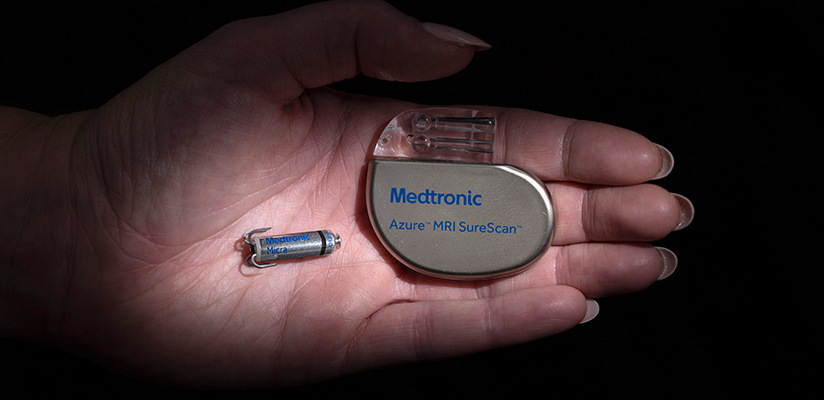Small But Mighty
It’s a device as small as a vitamin capsule, but it has the potential to change the way pacemakers are used for kids.
The Micra™ leadless pacemaker, first created for adults, is now used in 15 pediatric centers worldwide, including Le Bonheur Children’s. Designed for pacing slow and irregular heartbeats, Micra™ is the world’s smallest pacemaker that provides myriad benefits for children.
“The Micra™ is particularly beneficial for a child who needs pacing assistance every now and then,” said Karine Guerrier, DO, MPH, Le Bonheur’s director of Cardiac Electrophysiology and Cardiac Rhythm Device Management in the Heart Institute. “It takes minutes to place the device in the electrophysiology (EP) lab, which means less time under anesthesia. There is no incision, so no chest scar, and less risk for complications.”

Le Bonheur’s Heart Institute is helping pioneer the advancement of this device for its use in the pediatric population. Guerrier and Le Bonheur Pediatric Electrophysiologist Maria Elena Gutierrez, MD, have worked together to extend its use into the Memphis area and beyond.
The main objective of both the Micra™ and a standard pacemaker are the same in the case of heart block — pacing the ventricle. But the manner in which they achieve this objective is quite different due to the way they function and the method in which they are placed.
A standard pacemaker is about the size of a matchbox and surgically placed beneath the skin of the chest. In small children, this sometimes needs to be placed in the stomach because of the child’s size. One lead from the pacemaker connects to the right atrium and one to the right ventricle. The pacemaker monitors the activity in the atrium and then paces the ventricle to match its rate of pumping.
The Micra™ is placed via cath procedure directly into the right ventricle and attaches to the heart muscle via fishhook-like extensions. The device operates by sensing mechanical activity (heart motion and blood flow) from the atrium and then pacing the ventricle to match.
“Since the Micra™ device has no incision and no leads, that means no pocket-related complications, less chance for
endocarditis, caused when bacteria grow on the leads, and zero chance of lead fracture,” said Guerrier. “While the Micra™ does not replace standard pacemakers, it provides an option with a lower rate of intervention and chronic complications for patients who need occasional pacing.”

Members of Le Bonheur’s Heart Institute are able to place the Micra™ leadless pacemaker in just minutes. Pictured above after a procedure, the X-ray in the background shows the implanted device in the middle of the heart. Le Bonheur Pediatric Electrophysiologists Karine Guerrier, DO, MPH, (center with black lead) and Maria Elena Gutierrez, MD, (multicolor tie-dye lead) are each holding a Micra™ device. This device is placed via cath and does not require leads.
The process of placing the Micra™ is straightforward for both patient and physician. After determining a patient is a good fit for this type of pacemaker, Guerrier measures the size of the femoral and jugular veins, as the Micra™ requires vessel size of 9 mm or more for delivery via cath.
After obtaining access to the vein, Guerrier uses X-ray to guide the device into place and transesophageal echocardiogram (TEE) to confirm its position. From start to finish, this process takes 20 minutes compared to a potential two-hour surgery with a traditional pacemaker. This means less time under anesthesia for patients.
“Our patients are able to go home the day after receiving the Micra™ pacemaker,” said Guerrier. “When we see them in follow up at clinic, the Micra™ pacemaker can provide us with a report of how often it has been used since we last saw the patient.”
Micra™ also comes with fewer activity restrictions for children, both immediately after placement and long-term. A standard pacemaker requires weeks of activity restrictions after a new lead has been placed, such as avoiding strenuous exercise and certain upper body movements. Participation in contact sports may be restricted to help avoid displacing the leads. The Micra™ has two weeks of activity restrictions to allow the access site to heal and then no restrictions beyond that since the device embeds directly into the muscle of the heart and no leads are required.
“If the device could pace heart rates up to 180-200 beats per minute, then we could see more Micra™ devices on the pediatric side,” said Guerrier. “The leadless pacemaker has redefined the experience with pacing technology. We are excited about its prospect in pediatric patients who only need pacing occasionally.”
Benefits of Micra™ Leadless Pacemaker
- No incision and no chest scar or bump that occurs with standard pacemakers
- Reduced time under anesthesia
- Eliminates lead-related complications such as fractures and endocarditis
- Fewer activity restrictions immediately after the procedure and no activity restrictions after two weeks post-procedure
- Battery life of 15 years
- Reduction in the rate of reintervention and chronic complications
Help us provide the best care for kids.
Le Bonheur Children's Hospital depends on the generosity of friends like you to help us serve 250,000 children each year, regardless of their family’s ability to pay. Every gift helps us improve the lives of children.
Donate Now
















